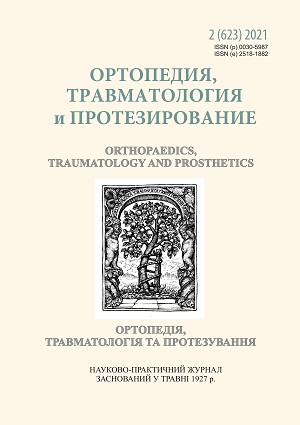3D-print in the planning of surgical treatment in the case of extraarticular deformity of lower limbs
DOI:
https://doi.org/10.15674/0030-59872021245-50Keywords:
Extraarticular deformity, malunion, lower extremity, 3D-printAbstract
An adequate planning of the curative measures is an important factor providing good functional results in the treatment of consequences of long bones injuries, in particular, malunions (post traumatic deformities). 3D-modeling in the preoperative planing gives an opportunity to assess both deformity itself and joint status. Visualization of injured segment with three-dimensional model manufactured using 3D-print in actual size (1:1 scale) provides additional capacities. Objective. To analyze the capacity provided by the usage of three-dimensional models of damaged segments in scale 1:1 while the planning of corrective surgery. Methods. Practicability of the usage of 3D-models, that was worked out on the base of CT-scanning, was studied in the treatment of 52 patients with different post traumatic extraarticular deformities of femur and tibia, after the fractures with intraarticular extension. Clinical results were evaluated using SF-36 and AOFAS scales. Results. Calculation for 3D-modeling was performed mostly virtually using standard computer programs with 3D-reconstruction, but 3D-print technology was used for 5 patients with the most severe and sophisticated deformities of the lower extremities. Changes in functional outcomes, according to SF-36 and AOFAS, for the patients undergone opera- tive treatment, were positive at 12 month of follow-up. Foreign colleagues expose analogous results of the investigations and suggest that the modeling with 3D-print provides mostly more safe, reliable and standardized clinical decisions for every particular patient. Conclusions. Preoperative usage of 3D-print on the stage of preoperative planing allows the surgeons to simulate different stages of operative intervention on the physical model, thus, help him to realize possible technical problems, choose adequate fixation device and proper instrumentation. It facilitates the shortening of surgery time, elimination of possible complications rate and achievement, in sum, good functional results in the treatment of this kind of patients.
References
- Solomin, L. N., Nazarov, V. A.,& Begun, P. I. (2005). Biomechanical bases of modular transformation of devices for transosseous osteosynthesis of long bones. Traumatology and Orthopedics of Russia, 4(38), 39–47. [in Russian]
- Khmyzov, S. A., Plotkin, A. V., & Tikhonenko, A. A. (2009). Modern methods of treatment of fractures and their consequences. Tavrichesky medical and biological bulletin, 4(52), 193–199. [in Russian]
- Paley, D. (2002). Principles of deformity correction. Springer-Verlag Berlin Heidelberg. https://doi.org/10.1007/978-3-642-59373-4
- Marti, R. K., & van Heerwaarden, R. J. (2008). Osteotomies for posttraumatic deformities. Georg Thieme Verlag. https://doi.org/10.1055/b-002-79369
- Yang, P., Du, D., Zhou, Z., Lu, N., Fu, Q., Ma, J., Zhao, L., & Chen, A. (2016). 3D printing-assisted osteotomy treatment for the malunion of lateral tibial plateau fracture. Injury, 47(12), 2816-2821. https://doi.org/10.1016/j.injury.2016.09.025
- Michielsen, M., Van Haver, A., Vanhees, M., Van Riet, R., & Verstreken, F. (2019). Use of three-dimensional technology for complications of upper limb fracture treatment. EFORT Open Reviews, 4(6), 302-312. https://doi.org/10.1302/2058-5241.4.180074
- Corona, P. S., Vicente, M., Tetsworth, K., & Glatt, V. (2018). Preliminary results using patient-specific 3d printed models to improve preoperative planning for correction of post-traumatic tibial deformities with circular frames. Injury, 49, S51-S59. https://doi.org/10.1016/j.injury.2018.07.017
- Xie, L., Chen, C., Zhang, Y., Zheng, W., Chen, H., & Cai, L. (2018). Three-dimensional printing assisted ORIF versus conventional ORIF for tibial plateau fractures: A systematic review and meta-analysis. International Journal of Surgery, 57, 35-44. https://doi.org/10.1016/j.ijsu.2018.07.012
- Bruns, N., & Krettek, C. (2019). 3D-printing in trauma surgery: Planning, printing and processing. Unfallchirurg. 122(4), 270–277. https://doi.org/10.1007/s00113-019-0625-9
- Wixted, C. M., Peterson, J. R., Kadakia, R. J., & Adams, S. B. (2021). Three-dimensional printing in orthopaedic surgery: Current applications and future developments. JAAOS: Global Research and Reviews, 5(4), e20.00230-11. https://doi.org/10.5435/jaaosglobal-d-20-00230
- Romanenko, K. K., Doluda, J. A., Prozorovsky, D. V., & Pariy, V. B. (2020). Clinical significance of post-traumatic deformities of long bones of lower extremities. Orthopedics, Traumatology and Prosthetics, 4, 72–79. https://doi.org/10.15674/0030-59872020472-79. [in Ukrainian]
- Prozorovsky, D. V. (2010). Evaluation of the results of surgical treatment of forefoot deformities, Ukrainian morphological almanac, 8(3), 61–63. [in Russian]
- Cook, J. J., Cook, E. A., Rosenblum, B. I., Landsman, A. S., & Roukis, T. S. (2011). Validation of the American College of foot and ankle surgeons scoring scales. The Journal of Foot and Ankle Surgery, 50(4), 420-429. https://doi.org/10.1053/j.jfas.2011.03.005
- Ware, J. E., Snow, K. K., Kosinski, M., & Gandek, B. (1993). SF-36 Health Survey. Manual and interpretation guide. The Health Institute, New England Medical Center. Boston : Mass
- Meinberg, E., Agel, J., Roberts, C., Karam, M., & Kellam, J. (2018). Fracture and dislocation classification compendium—2018. Journal of Orthopaedic Trauma, 32(1), S1-S10. https://doi.org/10.1097/bot.0000000000001063
- Charbonnier, B., Hadida, M., & Marchat, D. (2021). Additive manufacturing pertaining to bone: Hopes, reality and future challenges for clinical applications. Acta Biomaterialia, 121, 1–28. https://doi.org/10.1016/j.actbio.2020.11.039
Downloads
How to Cite
Issue
Section
License

This work is licensed under a Creative Commons Attribution 4.0 International License.
The authors retain the right of authorship of their manuscript and pass the journal the right of the first publication of this article, which automatically become available from the date of publication under the terms of Creative Commons Attribution License, which allows others to freely distribute the published manuscript with mandatory linking to authors of the original research and the first publication of this one in this journal.
Authors have the right to enter into a separate supplemental agreement on the additional non-exclusive distribution of manuscript in the form in which it was published by the journal (i.e. to put work in electronic storage of an institution or publish as a part of the book) while maintaining the reference to the first publication of the manuscript in this journal.
The editorial policy of the journal allows authors and encourages manuscript accommodation online (i.e. in storage of an institution or on the personal websites) as before submission of the manuscript to the editorial office, and during its editorial processing because it contributes to productive scientific discussion and positively affects the efficiency and dynamics of the published manuscript citation (see The Effect of Open Access).














